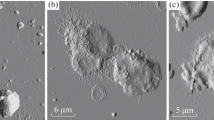Abstract
Rabbit neutrophils incubated in low-ionic-strength media were stimulated by ATP to secrete lysosomal enzymes. This was greatly enhanced in the presence of cytochalasin B. ATP in these circumstances induced the cell to form large cytoplasmic extensions that were largely devoid of granules. In the presence of both ATP and cytochalasin B, however, the projections contained granules in close proximity to the cell membrane. Neutrophils in low-ionic-strength buffer were capable of binding to zymosan particles coated with C3b but not of phagocytizing them. Release of granule enzymes was observed and exocytosis of granules appeared to occur at sites distant from those portions of the plasma membrane adherent to the particle.
Similar content being viewed by others
References
Henson, P.M. 1971. The immunologic release of constituents from neutrophil leukocytes. I. The role of antibody and complement on nonphagocytosable surfaces or phagocytosable particles.J. Immunol. 107:1535.
Weissmann, G., R.B. Zurier, P.J. Spieler, andI.N. Goldstein. 1971. Mechanisms of lysosomal enzyme release from leukocytes exposed to immune complexes and other particles.J. Exp. Med. 134:149.
Hawkins, D. 1971. Biopolymer membrane: A model system for the study of the neutrophilic response to immune complexes.J. Immunol. 107:344.
Henson, P.M. 1971. The immunologic release of constituents from neutrophil leukocytes. II. Mechanisms of release during phagocytosis, and adherence to nonphagocytosable surfaces.J. Immunol. 107:1547.
Henson, P.M. 1971. Interaction of cells with immune complexes: adherence, release of constituents, and tissue injury.J. Exp. Med. 134:114s.
Woodin, A.M., andA.A. Wieneke. 1970. Site of protein secretion and calcium accumulation in the polymorphonuclear leukocyte treated with leucocidin.In Calcium and Cellular Function. A.W. Cuthbent, editor. St. Martin's Press, New York. 183.
Hawkins, D. 1972. Neutrophilic leukocytes in immunologic reactions: evidence for the selective release of lysosomal constituents.J. Immunol. 108:310.
Becker, E.L., andP.M. Henson. 1973.In vitro studies of immunologically induced secretion of mediators from cells and related phenomena.In Advances in Immunology, V. 17. F.J. Dixon and H.G. Kunkel, editors. Academic Press, New York. 93.
Goldstein, I.M., S. Hoffstein, J. Gallin, andG. Weissmann. 1973. Mechanism of lysosomal enzyme release from human leukocytes: microtubule assembly and membrane fusion induced by a component of complement.Proc. Natl. Acad. Sci. 70:2916.
Becker, E.L., H.J. Showell, P.M. Henson, andL.S. Hsu. 1974. The ability of chemofactic factors to induce lysosomal enzyme release. I. The characteristics of the release, the importance of surfaces and the relation of enzyme release to chemotactic responsiveness.J. Immunol. 112:2024.
Becker, E.L., andP.M. Henson. 1975. Biochemical characteristics of ATP-induced secretion of lysosomal enzymes from rabbit polymorphonuclear leukocytes.Inflammation 1:71.
Henson, P.M., andZ.G. Oades. 1973. Enhancement of immunologically induced granule exocytosis from neutrophils by cytochalasin B.J. Immunol. 110:290.
Davies, P., R.I. Fox, M. Polyzonis, A.C. Allison, andA.D. Haswell. 1973. The inhibition of phagocytosis and facilitation of exocytosis in rabbit polymorphonuclear leukocytes by cytochalasin B.Lab. Invest. 28:16.
Becker, E.L., andH.J. Showell. 1974. The ability of chemotactic factors to induce lysosomal enzyme release. II. The mechanism of release.J. Immunol. 112:2045.
Zurier, R.B., G. Weissmann, S. Hoffstein, S. Kammerman, andH.H. Tai. 1974. Mechanisms of lysosomal enzyme release from human leukocytes. II. Effects of cAMP and cGMP, autonomic agonists, and agents which affect microtubule function.J. Clin. Invest. 53:297.
Freed, J.J., andM.M. Lebowitz. 1970. The association of a class of saltatory movements with microtubules in cultured cells.J. Cell Biol. 45:334.
Author information
Authors and Affiliations
Additional information
Support was provided by U.S.P.H.S. grant A1-07007 and GMS 19322-03 and by U.S.P.H.S. Career Development Award 1-KO4GM-42567-05 to Dr. P.M. Henson. This is publication no. 873 from the Department of Immunopathology, Scripps Clinic and Research Foundation, La Jolla, California.
Support was provided by U.S.P.H.S. grant A1-09648.
Rights and permissions
About this article
Cite this article
Henson, P.M., Henson, J.E. & Becker, E.L. Ultrastructural alterations during ATP-induced secretion of lysosomal enzymes from rabbit polymorphonuclear leukocytes. Inflammation 1, 85–91 (1975). https://doi.org/10.1007/BF00918061
Issue Date:
DOI: https://doi.org/10.1007/BF00918061



